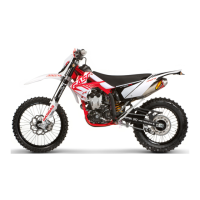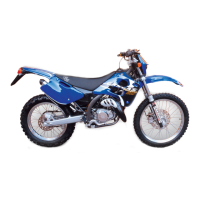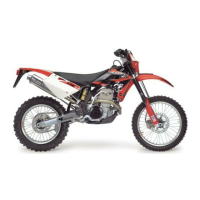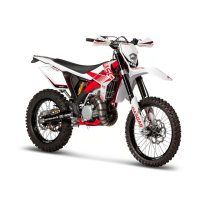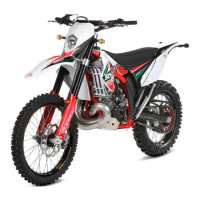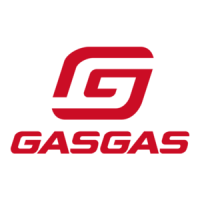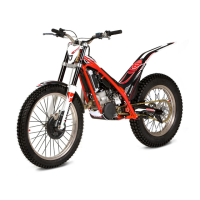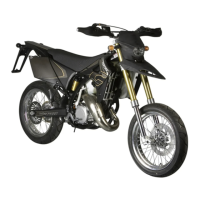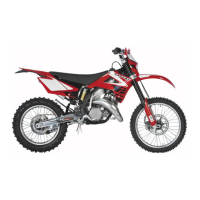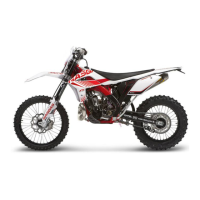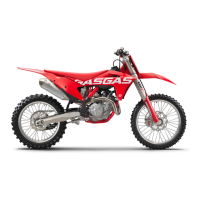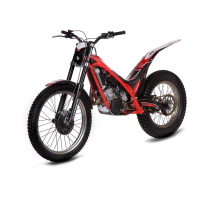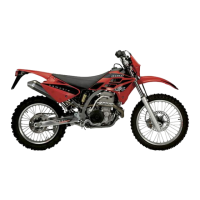
Do you have a question about the GAS GAS PAMPERA 450 - 2007 and is the answer not in the manual?
| Brand | GAS GAS |
|---|---|
| Model | PAMPERA 450 - 2007 |
| Category | Motorcycle |
| Language | English |
Introductory message from GAS GAS thanking the user and welcoming them to the family.
Identifies special instructions or procedures that, if not correctly followed, could result in personal injury or death.
Identifies special instructions or procedures that, if not strictly observed, could result in damage to or destruction of equipment.
Indicates points of particular interest for more efficient and convenient operation.
Details the engine type, displacement, bore and stroke, spark plug, fuel supply, and ignition.
Details transmission type, clutch, secondary transmission, and gear ratios.
Details chassis type and tyre sizes for front and rear.
Details front/rear suspension, types, stroke, oil levels, and brake specifications.
Details overall dimensions, fuel capacity, and vehicle weight.
Identifies clutch handle, start button, fuel cap, brake handles, and throttle control.
Identifies front suspension, radiator, fuel tank, air filter, seat, brake components, shift pedal, rear suspension, chain, and exhaust.
Details how to unfold the side stand and the note about engaging the security strap.
Specifies 98 octane unleaded petrol and fuel tank capacity.
Details octane rating methods, minimum requirements, and handling warnings.
Describes location of serial number and qualification approval plate.
Details steps to start the engine, including neutral gear and starter button use.
Details steps to stop the engine, including neutral gear and ignition key rotation.
Note regarding potential battery power loss when turning the ignition key to ON.
Explains cold start function and procedure, including notes.
Describes transmission and shifting process, including cautions.
Details steps for deceleration and braking.
Explains initial break-in, including notes and cautions.
Notes battery is maintenance-free and details removal steps.
Warns about hazards and provides charging instructions.
Explains coolant function and daily level checking, with warnings.
Details hose/radiator checks, anti-freeze info, and solution cautions.
Details checking and removing radiator cap, and adding coolant.
Cautions on coolant type, dilution, and freezing protection.
Instructions for checking level and recommended coolant type.
Details changing coolant process and warns about coolant on tires.
Details specs, gap, tightening, inspection, cleaning, and replacement notes.
Lists schedule and recommended plug types with comments.
Caution that incorrect spark plug fitting or heat grade can cause serious engine damage.
Details steps for removing the spark plug, involving seat and fuel tank removal.
Steps to access plug, handle cap, and warnings about fuel spillage.
Details cleaning carbon build-up and readjusting the spark plug gap to 0.7-0.8 mm.
Explains filter role, consequences of obstruction, and engine dirt entry.
Details cleaning steps, warnings about ventilation, flames, and not using petrol.
Checks that the throttle grip turns smoothly and has 2-3 mm of play.
Details adjusting throttle cable play using the locknut and adjuster, or carburetor adjustment.
Instructions for fitting the air filter, covering it with grease for a good seal and preventing dirt entry.
Specifies play and how to adjust the clutch lever.
Describes function, replacement, and silencer packing.
Details steps for changing silencer packing.
Covers chain wear, maintenance, tension check, and warnings.
Details steps for adjusting chain tension and axle nut tightening.
Notes on wheel alignment, warnings, and inspecting chain/sprocket wear.
Inspect chain guide slide and wear guide for wear or damage.
Inspect sprocket teeth and advice on lubricating the chain.
Details handlebar position adjustment and roller lubrication.
Notes automatic compensation for disc and pad wear.
Details adjusting front lever and rear pedal play.
Regularly check/change fluid, warnings on mixing and mushy feel.
Recommended fluid, level check, warnings, and pad replacement.
Ensures steering turns freely without excessive play.
Procedure to check steering adjustment by pushing handlebar and front fork for play or tightness.
Steps for adjusting steering tightness by loosening bolts and using a special spanner.
Explains how to use the steering lock mechanism by turning handlebars and inserting the key.
Caution never to leave the key in the lock, as turning the steering could damage it.
Front fork adjustments are done in two stages: adjusting the oil level and other adjustments.
Explains how higher or lower oil levels affect fork rebound speed in the final stage of travel.
Caution that front fork left and right tubes must be at the same level and aligned with the plate.
Details steps for adjusting fork oil level, including removing handlebars, caps, and springs.
Specifies SAE 7.5 as the recommended oil for front forks.
Adjusts suspension height according to the suspension tube height to 10 mm.
Describes the rear suspension components: shock absorber, swing arm, tie rods, and rocker arm.
Explains that spring preload and damping force can be adjusted for riding conditions.
Details steps for adjusting spring preload by removing seat, covers, silencer, and subchassis.
Provides specifications for the standard spring length (258 mm) and preload.
Advice on replacing rear shock absorber springs with stiffer or softer options based on rider weight and conditions.
Explains pressure affects traction/handling, adjust for conditions, test cold.
Ensure spoke tightness, check rim centring, and warnings.
Warning about improper removal of rear shock absorber spring ejecting parts at high velocity.
Prepare bike, cover sensitive areas, and identify care areas.
Warning on brake disc cleaning, and post-cleaning steps.
Ensure all bolts and nuts are tightened daily before riding and are in good condition.
List of components with corresponding numbers for checking bolt and nut tightness.
Lubricate points with motor oil or grease periodically, especially after washing or wet conditions.
Lists lubrication points: clutch lever, brake levers, rear brake pedal, rear brake bearing, and shift pedal.
Lubricate the chain after wet terrain or when dry, using high viscosity oil on rollers.
Recommends oil type, temperature guide, and oil level check.
Details oil change schedule and warns about hot oil/fumes.
Attention to oil hazards, storage, recycling, and hot engine oil change.
Details draining oil and replacing filter element and gasket.
Warning about incorrect oil filter fitting.
Position cover, bolt down, and warning about engine damage from incorrect oil.
Inspect filter intake, check oil level and top up.
Critical tuning, factors to consider, and adjustment principles.
Adjusting oil level affects upper fork stroke.
Guide to diagnosing and correcting poor settings with notes.
Details symptoms and cures for front fork and rear shock issues.
Discusses factory settings, rider adjustments, and surface type adjustments.
Advice for different rider experiences and track types.
Procedure to check suspension balance.
Addresses front end problems like searching downhill or knifing.
Addresses front fork response and rear tire traction problems.
Addresses bottoming on jumps and soft suspension with adjustments.
Note to always check front and rear compatibility after adjustments.
Advice for special care in dry/dusty, wet/muddy, and sandy conditions, focusing on air cleaner and chain.
Information regarding the availability of spare parts can be obtained from your Gas Gas dealer.
Checklist of tasks to perform monthly, including tightening bolts, checking fluid levels, and inspecting cables.
Details maintenance steps before storage: cleaning, warming oil, draining transmission oil, emptying fuel, disconnecting battery.
Specific actions for storage: lubricating cables, spraying oil on unpainted surfaces, raising wheels, covering exhaust pipe.
Steps to put the motorcycle back into use after storage: remove cover, check spark plug, fill fuel tank, check points, connect battery.
Describes the waterproof multifunction display, its LCD screen, and the information it provides (rpm, speed, journey, etc.).
Explanation of the symbols used for LED indicators like turn signals, headlights, and neutral gear.
Describes tachometer (bar/digital), max RPM, max speed, and average speed.
Covers ODO, TRIP, RT, TT, and Clock functions.
Explains gear change indicator and fuel level indicator.
Operation of the MODE button to switch between display screens and partial screens.
Operation of the RESET button to zero stored data like TRIP 2, MAX, MAX RPM, TRIP 1, AVG, and RT.
Procedure to set the gear change indicator by selecting RPM and confirming with the RESET button.
Configures clock, gear change indicator, engine revs, and units.
Setting clock format/time and gear change RPM level.
Configuring engine rev signal and wheel circumference.
Procedure for configuring the circumference value by adjusting the flashing digit.
Troubleshooting steps for when the starter motor does not work, checking fuses and battery.
Troubleshooting steps for when the engine does not rotate, checking crankshaft lock and transmission seizure.
Troubleshooting steps for when the engine rotates but does not start, checking fuel supply and spark plug.
Troubleshooting for engine start, overheating, and smooth running problems.
Troubleshooting for power loss, acceleration, and excessive oil consumption.
Troubleshooting for high oil consumption, noise, detonations, and fumes.
Troubleshooting for gears not engaging and exhaust system deterioration.
Troubleshooting for gears not engaging, jumping, and clutch slipping.
Troubleshooting for instability and hard/soft shock absorption.
Adjusting shock absorption and troubleshooting unusual bike noise.
Troubleshooting for handlebar vibrations.
Troubleshooting for pulling to one side and brake system problems.
Troubleshooting for lights blowing and lighting system not working.
Details the warranty period, starting from the vehicle delivery date.
Explains how to make warranty claims and conditions for claims not brought to an authorized dealer.
Details purchaser's obligations, such as submitting to inspections and using authorized parts/fluids.
Lists items not covered by warranty, including worn parts, consumables, and cosmetic damage.
GG decides on repairs, can demand parts return or expert inspection.
Options for unrepairable defects and purchaser rights against dealer.
Warranty unchanged on resale; excludes minor imperfections and ageing.
